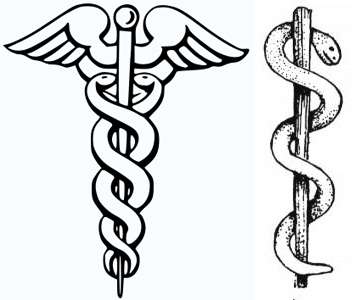Κι αυτό από το ηλεδελτίο του Michael Quinion:
Λεξιλόγιο:
talaria = φτερωτά πέδιλα, φτερά στα πόδια (στους αστραγάλους)
petasus = πέτασος (πλατύγυρο καπέλο, φτερωτό στην περίπτωση του Ερμή)
caduceus = κηρύκειο (ραβδί του κήρυκα, και του Ερμή, κήρυκα των θεών)
staff of Asclepius = ράβδος του Ασκληπιού

Κηρύκειο του Ερμή και ράβδος του Ασκληπιού
Απορία: έχουμε λέξη για το aglet, το προστατευτικό σιδεράκι στην άκρη των κορδονιών; (Μη μου πείτε το «περικαψύλιο» που είδα στη Ματζέντα.)
If we wanted to invent a classical replacement for the idiom "from head to toe", we might choose "from petasus to talaria". The latter is one of those words —like aglet for the little tube at the end of a shoelace or philtrum for the ridges in the middle of the upper lip— that identify something we know well but usually can't name.
These two words —and a third, "caduceus"— are associated with Hermes, the Greek herald and messenger of the gods whom the Romans knew as Mercury. He's usually portrayed as having wings on his sandals. The Romans called these "talaria", a plural noun from the adjective "talaris", relating to the ankle, from "talus", ankle.
Hermes was given his talaria by his father Zeus, who also gave him a low-crowned, broad-rimmed traveller's cap of a type well-known in classical times and which Greeks called a petasus. In later times, the hat changed to a brimless one with wings on, but it kept the name.
The third traditional item of equipment of Hermes and Mercury, the caduceus, was the wand of office of a Greek or Roman herald (it's from Greek "kerux", a herald), which usually had two snakes wound around a wooden staff. Long ago, this became confused with another rod, the staff of Asclepius, the god of healing, which only had the one snake; the twin-snake version of Hermes and Mercury replaced it and remains common as a symbol of medicine.
These two words —and a third, "caduceus"— are associated with Hermes, the Greek herald and messenger of the gods whom the Romans knew as Mercury. He's usually portrayed as having wings on his sandals. The Romans called these "talaria", a plural noun from the adjective "talaris", relating to the ankle, from "talus", ankle.
Hermes was given his talaria by his father Zeus, who also gave him a low-crowned, broad-rimmed traveller's cap of a type well-known in classical times and which Greeks called a petasus. In later times, the hat changed to a brimless one with wings on, but it kept the name.
The third traditional item of equipment of Hermes and Mercury, the caduceus, was the wand of office of a Greek or Roman herald (it's from Greek "kerux", a herald), which usually had two snakes wound around a wooden staff. Long ago, this became confused with another rod, the staff of Asclepius, the god of healing, which only had the one snake; the twin-snake version of Hermes and Mercury replaced it and remains common as a symbol of medicine.
Λεξιλόγιο:
talaria = φτερωτά πέδιλα, φτερά στα πόδια (στους αστραγάλους)
petasus = πέτασος (πλατύγυρο καπέλο, φτερωτό στην περίπτωση του Ερμή)
caduceus = κηρύκειο (ραβδί του κήρυκα, και του Ερμή, κήρυκα των θεών)
staff of Asclepius = ράβδος του Ασκληπιού

Κηρύκειο του Ερμή και ράβδος του Ασκληπιού
Απορία: έχουμε λέξη για το aglet, το προστατευτικό σιδεράκι στην άκρη των κορδονιών; (Μη μου πείτε το «περικαψύλιο» που είδα στη Ματζέντα.)


